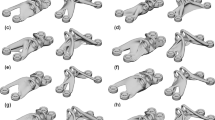Abstract
Additive manufacturing (AM) involves construction of 3D parts by sequentially adding material to a component and has undergone advancements in the range of materials used and the complexity of parts being printed. Laser powder bed fusion (LPBF) AM, which is the focal point of this work, has sparked interest in the materials and manufacturing community. LPBF has the ability to print complex designs, which may reduce production costs depending on materials, machine, time to print the part, and desired part quality. These complex designs introduce complex processing spaces, resulting in local processing heterogeneities, which may limit the application of LPBF. Hence, there is a need to develop methods to efficiently search for process parameter sets that reduce local processing heterogeneities. We present an optimization methodology implemented to demonstrate the advantages of locally tailored process parameters to produce a more homogeneous component. The optimization is applied to two geometries, using an optimized single parameter set for the entire geometry and locally optimized scan parameters developed based on vector level analysis. Lastly, we show how different optimized scan parameter sets can be related to the different subregions in the part in a generalized way to be applied to numerous geometries without retraining.





















Similar content being viewed by others
References
J.-Y. Lee, J. An, and C.K. Chua, Appl. Mater. Today 7, 120 (2017).
S. Srinivasan, B. Swick, and M.A. Groeber, JOM 72, 4393 (2020).
J. Jiang and Y. Ma, Micromachines 11, 633 (2020).
L. Englert, S. Czink, S. Dietrich, and V. Schulze, J. Mater. Process. Technol. 299, 117331 (2022).
M.J. Matthews, G. Guss, S.A. Khairallah, A.M. Rubenchik, P.J. Depond, and W.E. King, Acta Mater. 114, 33 (2016).
E.J. Schwalbach, S.P. Donegan, M.G. Chapman, K.J. Chaput, and M.A. Groeber, Addit. Manuf. 25, 485 (2019).
B. Stump, A. Plotkowski, and J. Coleman, Model. Simul. Mater. Sci. Eng. 29, 035001 (2021).
J. Lin, E. Keogh, S. Lonardi, B. Chiu, in DMKD ’03 Proceedings of the 8th ACM SIGMOD Workshop on Research Issues in Data Mining and Knowledge Discovery (2003).
E. Duong, L. Masseling, C. Knaak, P. Dionne, and M. Megahed, Addit. Manuf. Lett. 3, 100047 (2022).
R.L. Iman, Encyclopedia of Quantitative Risk Analysis and Assessment (John Wiley & Sons, Ltd, 2008).
H. Yeung, B. Lane, and J. Fox, Addit. Manuf. 30, 100844 (2019).
C.L. Druzgalski, A. Ashby, G. Guss, W.E. King, T.T. Roehling, and M.J. Matthews, Addit. Manuf. 34, 101169 (2020).
T. Szandała, in Bio-Inspired Neurocomputing. ed. by A.K. Bhoi, P.K. Mallick, C.-M. Liu, and V.E. Balas (Springer, Singapore, 2021), pp. 203–224.
A.J. Smola and B. Schölkopf, Stat. Comput. 14, 199 (2004).
D. Berrar, in Encyclopedia of Bioinformatics and Computational Biology. ed. by S. Ranganathan, M. Gribskov, K. Nakai, and C. Schönbach (Academic Press, Oxford, 2019), pp. 542–545.
K. Weiss, T.M. Khoshgoftaar, and D. Wang, J. Big Data 3, 9 (2016).
L. Torrey and J. Shavlik, in Handbook of Research on Machine Learning Applications and Trends: Algorithms, Methods, and Techniques. ed. by E.S. Olivas, J.D.M. Guerrero, M. Martinez-Sober, R. Magdalena-Benedito, and A.J.S. Lopez (IGI Global, Hershey, 2010), pp. 242–264.
Author information
Authors and Affiliations
Corresponding author
Ethics declarations
Conflict of interest
The authors have no conflicts of interest.
Additional information
Publisher's Note
Springer Nature remains neutral with regard to jurisdictional claims in published maps and institutional affiliations.
Rights and permissions
Springer Nature or its licensor (e.g. a society or other partner) holds exclusive rights to this article under a publishing agreement with the author(s) or other rightsholder(s); author self-archiving of the accepted manuscript version of this article is solely governed by the terms of such publishing agreement and applicable law.
About this article
Cite this article
Srinivasan, S., Swick, B. & Groeber, M.A. Optimization of Local Processing Conditions in Complex Part Geometries Through Novel Scan Strategy in Laser Powder Bed Fusion Process. JOM 76, 99–113 (2024). https://doi.org/10.1007/s11837-023-06255-x
Received:
Accepted:
Published:
Issue Date:
DOI: https://doi.org/10.1007/s11837-023-06255-x




